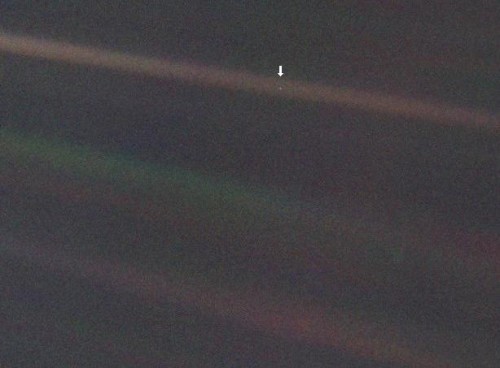This is a picture of Earth taken by the spacecraft Voyager 1 from almost 4 billion miles (more than 6 billion kilometers) away from Earth. The light band over Earth is caused by the sun and is only there by chance. Earth is less than one pixel in this photograph, .12 pixels according to NASA. Kinda makes you feel small, doesn\’t it?
The second photo is The Blue Marble and was taken by Apollo 17 astronauts from a mere 18,000 miles away (29,000km).









hey, I live there!
my girlfriend says ” i dont believe that little dot is the earth, there’s no proof that this picture is actually from NASA.” i said “what?”
@...LeeHarveyOswald: …and she’s still your girlfriend? I hope she said that standing naked in the kitchen making you a sammich.
carl sagan – www.youtube.com/watch?v=p86BPM1GV8M
I’ve made a spreadsheet that calculates diameters and distances of our Solar Systems planets in different scales. I think it’s very interesting, and makes it very easy to see exactly how big our Solar System is.
For example, if the Earth was the size of a golf ball (1 11/16″ diameter), our Solar System would look like this:
Sun – 15′ diameter
Mercury – 5/8″ diameter; 649′ away from Sun
Venus – 1 9/16″ diameter; 1,136′ away from Sun
Earth – 1 11/16″ diameter; 1,623′ away from Sun
Mars – 13/16″ diameter; 2,435′ away from Sun
Jupiter – 1’6 13/16″ diameter; 8,442′ away from Sun
Saturn – 1’3 13/16″ diameter; 15,423′ away from Sun
Uranus – 6 3/4″ diameter; 31,819′ away from Sun
Neptune – 6 1/2″ diameter; 48,703′ away from Sun
This means that with a 15′ diameter Sun, our Solar System would have a diameter of almost 18 1/2 miles.
Pretty amazing…
If the Earth was the still the size of a Golf Ball, then 4 billion miles would be equal to 13.68 miles.
That is a picture of a golf ball from 13.68 miles away.
@...Anonymous: I know it’s not techically a planet anymore but what is the size of Pluto and its distance from the sun in relationship to your scale model?
Our how about the next closest star Alpha Centauri? (Not sure spelling and too lazy to look it up)
Since Pluto has an oval-shaped orbit, I took the mean orbital radius of its aphelion and perihelion orbits.
With Earth the size of a golf ball:
Pluto – 1/4″ diameter; 64,068′ away from Sun
Alpha Centauri – 18′-6 3/8″ diameter; 102,624,153′ away from Sun (or 19,436.39 miles)
Oops. I made a mistake. 19,436.39 miles would actually be a Light Year. The distance of Alpha Centauri would be 84,839.85 miles.
If you made the orbit of Neptune fit inside Yankee Field (408′ diameter), then:
Sun – 3/4″ diameter
Alpha Centauri – 355 miles away from Sun
@...Anonymous:
en.wikipedia.org/wiki/Solar_system_model
Thanks, HoChunk.
I actually built my spreadsheet at work one day when I was bored. We’d just fabricated a 16′ diameter globe out of aluminum, and I was curious how big the solar system would be around it.